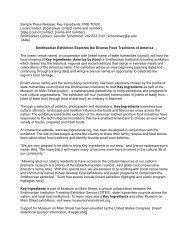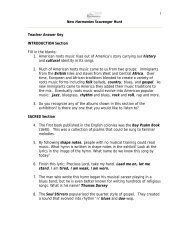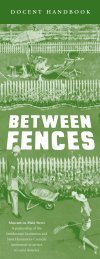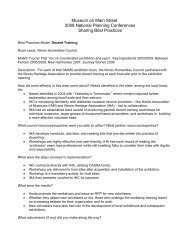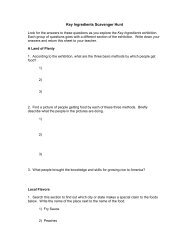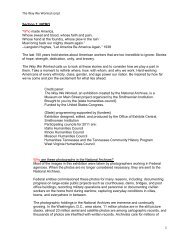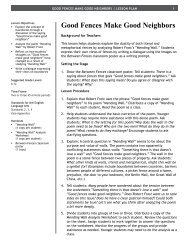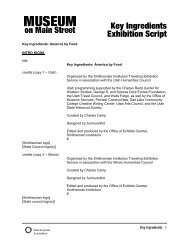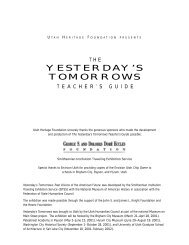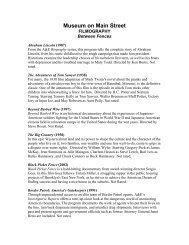How Do I Become a Great Docent for - Museum on Main Street
How Do I Become a Great Docent for - Museum on Main Street
How Do I Become a Great Docent for - Museum on Main Street
Create successful ePaper yourself
Turn your PDF publications into a flip-book with our unique Google optimized e-Paper software.
It’s All About TimingYour tour of Between Fences should take between 30 and 45 minutes; however,most venues advertise hour-l<strong>on</strong>g tours. This will give you some leeway in managing yourtour. In some instances, the tour discussi<strong>on</strong> may go <strong>on</strong> l<strong>on</strong>ger than it should. It may <strong>on</strong>lyinclude a few visitors while the rest of the group becomes restless or bored. There maybe another tour group waiting. No matter the reas<strong>on</strong>, it is the docent’s resp<strong>on</strong>sibility tolimit the discussi<strong>on</strong>, then guide the tour group to the next kiosk. Use a comment like: I’msure we could talk about this subject <str<strong>on</strong>g>for</str<strong>on</strong>g> hours, but I do want you to enjoy the rest of theexhibiti<strong>on</strong>.Know Who’s BossYou may occasi<strong>on</strong>ally experience an unhappy, unruly, or disruptive visitor. If youhave an unruly student <strong>on</strong> your tour, remain calm and focused. Encourage his/herparticipati<strong>on</strong> in the discussi<strong>on</strong>. If the problem persists, ask the teacher or adultchaper<strong>on</strong>e to remove the student from the tour. You are not resp<strong>on</strong>sible <str<strong>on</strong>g>for</str<strong>on</strong>g> discipline;you are resp<strong>on</strong>sible <str<strong>on</strong>g>for</str<strong>on</strong>g> a great tour.If you are dealing with an unhappy or disruptive adult, calmly explain that his/hercomments are interfering with the other visitors’ enjoyment of the tour and ask him/her torefrain from the behavior. Most museums and other exhibiti<strong>on</strong> venues have policies inplace <str<strong>on</strong>g>for</str<strong>on</strong>g> dealing with disruptive visitors. Check the venue’s policy and defer to it if youfind yourself in a sticky or uncom<str<strong>on</strong>g>for</str<strong>on</strong>g>table situati<strong>on</strong>.Know Your Own “Star Power”In a way, docents are per<str<strong>on</strong>g>for</str<strong>on</strong>g>mers, so stage presence makes a difference. Hereare some things to remember about per<str<strong>on</strong>g>for</str<strong>on</strong>g>ming your “starring role” as a docent:• Follow your museum’s guidelines <str<strong>on</strong>g>for</str<strong>on</strong>g> attire, name tags, etc.• Be c<strong>on</strong>fident! If you believe you could be Hollywood’s next big star, your visitors willtoo!• Facial expressi<strong>on</strong>s are the primary way we assess each other’s feelings, so SMILE! Afriendly face will put visitors at ease and make them feel welcome. But d<strong>on</strong>’t let thatsmile get stuck <strong>on</strong> your face. You’ll naturally resp<strong>on</strong>d to visitors’ comments and5
• Speak clearly; try to enunciate or articulate your words precisely. Try a few t<strong>on</strong>guetwisters be<str<strong>on</strong>g>for</str<strong>on</strong>g>e your tour to get your mouth, lips, and t<strong>on</strong>gue loosened up and workingtogether. You’ll lose your audience’s interest in no time if they can’t understand you.• Make sure you can be heard. Think of “projecting” rather than speaking loudly.Shouting uses <strong>on</strong>ly your voice and it strains it as well. Support your c<strong>on</strong>versati<strong>on</strong> withlungs full of air. Let your diaphragm push out or “project” your words <strong>on</strong> a stream of air.Think of a musician squeezing a bagpipe with his/her elbow, <str<strong>on</strong>g>for</str<strong>on</strong>g>cing air into the pipes.Good projecti<strong>on</strong> is based <strong>on</strong> that same principle. If you are getting a crowd of blankstares, ask your audience if they can hear you. If not, you’ll have to project a little better!• Limit the use of “um,” “you know,” and “like” from your vocabulary … or at least try to.These pause fillers disrupt the flow of your tour. They may also make you seem nervousor unprepared. Be aware of these pause fillers and try to avoid them. There isnothing wr<strong>on</strong>g with a few sec<strong>on</strong>ds of silence while you find the right word or collect yourthoughts.Know <str<strong>on</strong>g>How</str<strong>on</strong>g> to PracticeOnce you’ve explored Between Fences, read the docent handbook, and thoughtabout the themes of the exhibiti<strong>on</strong>, it’s time to start practicing <str<strong>on</strong>g>for</str<strong>on</strong>g> your tour. Practiceintroducing yourself and welcoming your visitors. Then, walk through the exhibiti<strong>on</strong> againand see what objects and images catch your eye. What aspects of the exhibiti<strong>on</strong> mostinterest you? The ideas and thoughts you have will guide you in developing your tour.Another good way to practice is to ask questi<strong>on</strong>s. Start a c<strong>on</strong>versati<strong>on</strong> at thedinner table, in the office, or at a local gathering place. Ask your family and friends a fewquesti<strong>on</strong>s like: What kinds of fences were in the community where you grew up? or Whatfeelings do you associate with white picket fences? Really listen to their resp<strong>on</strong>ses. Thispractice will prepare you <str<strong>on</strong>g>for</str<strong>on</strong>g> the c<strong>on</strong>versati<strong>on</strong>s you will have with visitors to theexhibiti<strong>on</strong>.After leading a few tours, meet with other docents and share your experiences.Find out how they answered an unexpected or challenging questi<strong>on</strong>. Share with themhow you structured your tour to a mixed group of older adults and their grandchildren.Take tours led by fellow docents; you’ll be surprised at what you can learn from other7
docents’ tours and they from yours. <str<strong>on</strong>g>Do</str<strong>on</strong>g>n’t be shy about incorporating others’ good ideasand successful techniques into your tours.Know You Can <str<strong>on</strong>g>Do</str<strong>on</strong>g> It!There is a great deal of in<str<strong>on</strong>g>for</str<strong>on</strong>g>mati<strong>on</strong> here about becoming a terrific docent, but itis not as challenging as you might think. The most important thing to remember is torelax and enjoy your tour. Most docents feel relaxed when they have a good grasp of thein<str<strong>on</strong>g>for</str<strong>on</strong>g>mati<strong>on</strong> in the exhibiti<strong>on</strong>, so explore Between Fences, then read and practice withthe docent handbook. Be sure to use your new “great docent” skills as you lead toursthrough any Between Fences compani<strong>on</strong> exhibits or displays and permanentexhibiti<strong>on</strong>s at your museum.8
Guidelines <str<strong>on</strong>g>for</str<strong>on</strong>g> Structuring Tours to Family and Student GroupsFamily Tour GroupsAmerican families are more diverse than ever, but a family acts like a family nomatter its makeup or nati<strong>on</strong>ality.Families• Family members receive and share in<str<strong>on</strong>g>for</str<strong>on</strong>g>mati<strong>on</strong> from each other.• Family members learn through c<strong>on</strong>versati<strong>on</strong> and social interacti<strong>on</strong>.• Families members come in all ages—from infants to grandparents.• Because families are busier than ever, they sometimes have less time to spend at theexhibiti<strong>on</strong> than do scheduled groups.• Families need to know where rest rooms, water fountains, and food c<strong>on</strong>cessi<strong>on</strong>s arelocated.Hints <str<strong>on</strong>g>for</str<strong>on</strong>g> Leading Family Tours• Be clear about the length of the tour.• Make sure you address both children and adults.• Be sensitive to the fact that adults accompanying the children may not be their parents.• Create a team spirit by encouraging adults and children to answer questi<strong>on</strong>s andexamine objects together.• Tell children that their “job” is to assist the adults in solving problems or answeringquesti<strong>on</strong>s.• <str<strong>on</strong>g>Do</str<strong>on</strong>g>n’t be insulted if a family must leave be<str<strong>on</strong>g>for</str<strong>on</strong>g>e the tour is over.Adult Tour GroupsAdults and Older Adults• visit museums to increase their knowledge• may have little use <str<strong>on</strong>g>for</str<strong>on</strong>g> specific in<str<strong>on</strong>g>for</str<strong>on</strong>g>mati<strong>on</strong>, but may find insight into something familiarHints <str<strong>on</strong>g>for</str<strong>on</strong>g> Leading Adult and Older Adult Group Tours• Avoid alienating adult visitors by talking to them like students.• <str<strong>on</strong>g>Do</str<strong>on</strong>g> not underestimate older adults; tap their wisdom and experience.• Interpret the exhibiti<strong>on</strong> <strong>on</strong> the basis of relevance to the past, present and future culturalc<strong>on</strong>texts.9
• Older adults may be intellectually sharp, but physical limitati<strong>on</strong>s may require shortertours or time <str<strong>on</strong>g>for</str<strong>on</strong>g> rest.• Background noise may interfere with hearing, so find a quiet spot <str<strong>on</strong>g>for</str<strong>on</strong>g> discussi<strong>on</strong>.• Speak audibly and clearly.Student Tour GroupsPre-kindergarten–2nd Grade Students• have vivid imaginati<strong>on</strong>s and like to pretend• have short attenti<strong>on</strong> spans• are more physically oriented than verbally oriented• str<strong>on</strong>gly identify with their namesHints <str<strong>on</strong>g>for</str<strong>on</strong>g> Leading Pre-kindergarten–2nd Grade Student Tours• Employ activities that allow children to discover things—d<strong>on</strong>’t tell them, ask them.• Ask children to look or touch, then describe.• Ask children to solve a riddle.• Tell stories.• If students are wearing nametags, call them by their names.3rd Grade–5th Grade Students• are avid observers• are eager to learn new things• like to talk• love being challenged to find objects or clues• work well <strong>on</strong> independent assignmentsHints <str<strong>on</strong>g>for</str<strong>on</strong>g> Leading 3rd Grade–5th Grade Student Tours• Ask children to hunt <str<strong>on</strong>g>for</str<strong>on</strong>g> an image or an object in the exhibiti<strong>on</strong>.• Ask children to describe that image or object.6th Grade–9th Grade Students• are aware of their appearance• are peer centered• like to work in groups10
• can be distrusting of adults• have an uninterested air about them (they seem like they d<strong>on</strong>’t want to learn or d<strong>on</strong>’tcare)Hints <str<strong>on</strong>g>for</str<strong>on</strong>g> Leading 6th Grade–9th Grade Student Tours• Treat adolescents with respect and as adults.• Ask open-ended questi<strong>on</strong>s that allow them to express their opini<strong>on</strong>s.• Ask pointed questi<strong>on</strong>s (<str<strong>on</strong>g>Do</str<strong>on</strong>g> you think America’s physical border boundaries or fencesare doing their jobs? Why or why not?).• Give group-oriented assignments.• With the teacher’s permissi<strong>on</strong>, give adolescent students time to visit some of theexhibiti<strong>on</strong> <strong>on</strong> their own.• <str<strong>on</strong>g>Do</str<strong>on</strong>g>n’t take whispering, giggling, or imitating pers<strong>on</strong>ally.• <str<strong>on</strong>g>Do</str<strong>on</strong>g>n’t take yourself too seriously; keep your sense of humor.• <str<strong>on</strong>g>Do</str<strong>on</strong>g>n’t ask them to sit <strong>on</strong> the floor in a circle.10th Grade–12th Grade Students• have str<strong>on</strong>g opini<strong>on</strong>s about what they find interesting and relevant to their lives• have l<strong>on</strong>ger attenti<strong>on</strong> spans• like doing activities al<strong>on</strong>e or with friends• are peer centered• often are compelled to challenge the status quoHints <str<strong>on</strong>g>for</str<strong>on</strong>g> Leading 10th Grade–12th Grade Student Tours• Let students express their opini<strong>on</strong>s and provide opportunities <str<strong>on</strong>g>for</str<strong>on</strong>g> them to givefeedback.• Ask a provocative questi<strong>on</strong> or make a provocative statement at the beginning of thetour. Ask the same questi<strong>on</strong> at the end of the tour to test if opini<strong>on</strong>s, values, orpercepti<strong>on</strong>s have changed.• Create a debate over a value-laden or emoti<strong>on</strong>al issue.• With the teacher’s permissi<strong>on</strong>, build in some flexible or free time to their visit.11



